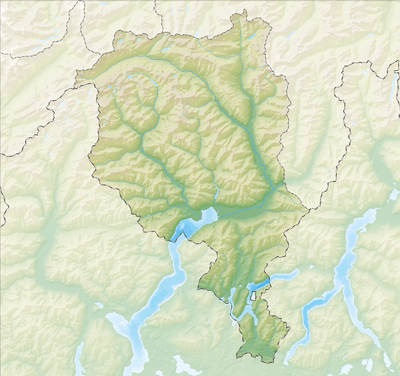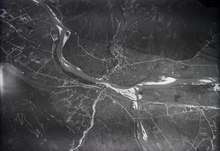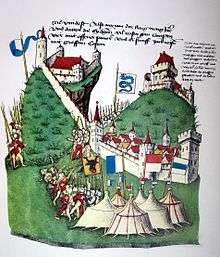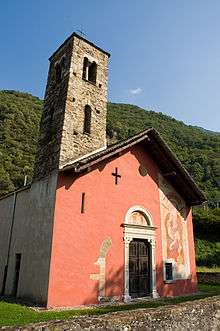Arbedo-Castione
Arbedo-Castione is a municipality in the district of Bellinzona in the canton of Ticino in Switzerland.
Arbedo-Castione | |
|---|---|
 | |
 Coat of arms | |
Location of Arbedo-Castione 
| |
 Arbedo-Castione  Arbedo-Castione | |
| Coordinates: 46°13′N 9°03′E | |
| Country | Switzerland |
| Canton | Ticino |
| District | Bellinzona |
| Government | |
| • Mayor | Sindaco |
| Area | |
| • Total | 21.52 km2 (8.31 sq mi) |
| Elevation | 283 m (928 ft) |
| Population (2018-12-31)[2] | |
| • Total | 5,105 |
| • Density | 240/km2 (610/sq mi) |
| Postal code | 6517 |
| SFOS number | 5001 |
| Surrounded by | Bellinzona, Claro, Gnosca, Gorduno, Lumino, Roveredo (GR), Sant'Antonio |
| Website | www SFSO statistics |
History

The Early Bronze Age Hoard of Castione (from about 1800 BC.) contains material from north of the Alps. This large find indicates that the area was an important trading and transportation center during the Bronze Age. A Late Bronze Age settlement (from about 1300 BC.) is indicated by evidence of digging and traces of a number of cremation sites. The bulk of the finds come from the five groups of tombs at Castione, Castione-Bergamo, Cerinasca d'Arbedo, Molinazzo d'Arbedo and S. Paolo d'Arbedo, which are dated to the Hallstatt and Latène eras. The tombs were discovered at the end of the 19th Century during the construction of the Gotthard Railway, but probably were only partially excavated. Most of the finds are in Swiss National Museum.[3]
Starting in the 6th Century, both buried cremation urns and full body graves became common, though later only bodies were buried. The cremation ashes were buried in stone cists or pits, while bodies were buried in stone lined tombs under deck plates were made of gneiss. The dead were buried with their possessions (brooches, belts and jewelry). In the Latène era, isolated swords and helmets were added to the men's graves. The women's graves began to contain a number of amber objects, such as earrings and necklaces. Within the grave there were also containers, usually made of clay (pots, bowls, cups, cans), or occasionally bronze (Situlae or beak jugs). While these are a few imports from Etruria (8 beak jug, 1 bucket), most of the items were produced in the area. The large bronze hoard of Arbedo dates from the period around 450 BC. Over 4,000 items were discovered in Arbedo along with smelting furnaces and workshop waste. In addition to local products, there are numerous important Etruscan and northern Alpine objects.[3]
While a specific foundation date is still unknown, numerous grave groups close to a settlement on the valley floor date from the 6th Century. Together with the graves near Como and Castelletto Ticino-Golasecca, Arbedo-Castione formed the third center of the Golasecca culture. The settlement occupied a key position on major trade routes, as imports from Etruria and from north of the Alps indicate. The hoard of Arbedo shows that there were also workshops for the population. The graves at Arbedo also document the gallic invasion of the Po river valley around 390 BC. A few Roman era objects have been discovered at Castione and S. Paolo d'Arbedo.[3]

Several 7th Century graves have been discovered, one is at the Church of S. Paolo and six are in Castione. One of the graves contained a gold coin with the name of the Lombard King Agilulf. The graves surround the original church of S. Paolo and indicate that Lombards family had a presence in the valley and may have had a family chapel there. The building is close to the castrum of Bellinzona, where the Lombards had settled in 590. Additionally, it was right next to the old main road leading from Castelseprio at Varese on the Monte Ceneri to Lukmanier Pass. Throughout the Middle Ages Arbedo was an important transit point on the routes over several central Alpine passes. The natural barriers of the Ticino and Moesa provided excellent defenses for the village and made it a gateway to Bellinzona. However, its position led to frequent battles around and in Arbedo. The Battle of Arbedo in 1422 ended Swiss territorial expansion for some time. The 1449 Battle of Castione ended when the Condottiere Giovanni della Noce burned the village down and forced the armies of Uri and its allies to flee into the Val Mesolcina.[4]
Arbedo and Castione are first mentioned in 1195 as Erbedum. In 1237 it was mentioned as Castillionum. In a book of records for the city of Como from 1335 the village of Pitadino which might correspond to Castione.[5]
Two churches are mentioned at the bridge over the Moesa, though they no longer exist. The church of S. Christopher was built in 1284 and the church of S. Elena was from 1441. It is likely that they were destroyed when the river flooded. At the center of Arbedo was the church of Santa Maria, which became a parish church in 1583.[4]
A pillar-supported wooden bridge was built over the Moesa during the Middle Ages. The bridge maintenance was paid for by the village of the County of Bellinzona, which included Arbedo. The bridge was in a strategic position and in 1495 it was destroyed to slow the Swiss Confederation army. The army then turned and marched in the direction of Lombardy. Also important for trader traffic the stone bridge over the stream Traversagna, which was built in 1485. In the southern foreland, various canals were built which supplied water and power to mills and sawmills that were used throughout the region.
Today, Arbedo is a residential suburb of Bellinzona and the center of small and medium-sized industrial and service enterprises (quarries, gravel and sand extraction, storage). The Valle di Arbedo still has extensive forest resources though some of the trees were destroyed in a 1928 by a landslide on Mount Arbino.[4]
Geography

Arbedo-Castione has an area, as of 1997, of 21.28 square kilometers (8.22 sq mi). Of this area, 1.27 km2 (0.49 sq mi) or 6.0% is used for agricultural purposes, while 16.51 km2 (6.37 sq mi) or 77.6% is forested. Of the rest of the land, 1.88 km2 (0.73 sq mi) or 8.8% is settled (buildings or roads), 0.39 km2 (0.15 sq mi) or 1.8% is either rivers or lakes and 0.86 km2 (0.33 sq mi) or 4.0% is unproductive land.
Of the built up area, industrial buildings made up 1.8% of the total area while housing and buildings made up 2.9% and transportation infrastructure made up 2.8%. Power and water infrastructure as well as other special developed areas made up 1.3% of the area. Out of the forested land, 74.5% of the total land area is heavily forested and 1.6% is covered with orchards or small clusters of trees. Of the agricultural land, 2.6% is used for growing crops and 2.9% is used for alpine pastures. Of the water in the municipality, 0.2% is in lakes and 1.6% is in rivers and streams. Of the unproductive areas, 3.1% is unproductive vegetation.[6]
The municipality is located in the Bellinzona district on the left bank of the Moesa river near the confluence with the Tessin river, south of Piz de Molinera. It consists of the villages of Arbedo and Castione.
Coat of arms
The blazon of the municipal coat of arms is Azure a Lion passant Argent holding a Palm Branch Vert between three Mullets Or on a Bridge of the last in its Arch three barrulets engrailed.[7]
Demographics
Arbedo-Castione has a population (as of December 2018) of 5,103.[8] As of 2008, 29.5% of the population are foreign nationals.[9] Over the last 10 years (1997–2007) the population has changed at a rate of 3.6%. Most of the population (as of 2000) speaks Italian(88.8%), with German being second most common ( 3.7%) and Serbo-Croatian being third ( 2.4%).[10]
Of the Swiss national languages (as of 2000), 139 speak German, 43 people speak French and 3,313 people speak Italian. The remainder (234 people) speak another language.[11]
As of 2008, the gender distribution of the population was 49.7% male and 50.3% female. The population was made up of 1,411 Swiss men (33.6% of the population), and 678 (16.1%) non-Swiss men. There were 1,583 Swiss women (37.7%), and 528 (12.6%) non-Swiss women.[12]
In 2008 there were 22 live births to Swiss citizens and 9 births to non-Swiss citizens, and in same time span there were 22 deaths of Swiss citizens and 3 non-Swiss citizen deaths. Ignoring immigration and emigration, the population of Swiss citizens remained the same while the foreign population increased by 6. There was 1 Swiss man, 1 Swiss woman who emigrated from Switzerland to another country, 31 non-Swiss men who emigrated from Switzerland to another country and 15 non-Swiss women who emigrated from Switzerland to another country. The total Swiss population change in 2008 (from all sources) was an increase of 62 and the non-Swiss population change was an increase of 53 people. This represents a population growth rate of 2.9%.[9]
The age distribution, as of 2009, in Arbedo-Castione is; 387 children or 9.2% of the population are between 0 and 9 years old and 411 teenagers or 9.8% are between 10 and 19. Of the adult population, 492 people or 11.7% of the population are between 20 and 29 years old. 549 people or 13.1% are between 30 and 39, 742 people or 17.7% are between 40 and 49, and 612 people or 14.6% are between 50 and 59. The senior population distribution is 500 people or 11.9% of the population are between 60 and 69 years old, 338 people or 8.0% are between 70 and 79, there are 169 people or 4.0% who are between 80 and 89.[12]
As of 2000, there were 1,452 private households in the municipality, and an average of 2.5 persons per household.[10] In 2000 there were 695 single family homes (or 74.3% of the total) out of a total of 935 inhabited buildings. There were 120 two family buildings (12.8%) and 87 multi-family buildings (9.3%). There were also 33 buildings in the municipality that were multipurpose buildings (used for both housing and commercial or another purpose).[13]
The vacancy rate for the municipality, in 2008, was 0.91%. Of the apartments, a total of 1,431 apartments (88.4% of the total) were permanently occupied, while 107 apartments (6.6%) were seasonally occupied and 80 apartments (4.9%) were empty.[14] In 2000 there were 1,618 apartments in the municipality. The most common apartment size was the 4 room apartment of which there were 626. There were 62 single room apartments and 384 apartments with five or more rooms.[14] As of 2007, the construction rate of new housing units was 9.7 new units per 1000 residents.[10]
The historical population is given in the following table:[5]
| year | population |
|---|---|
| 1801 | 420 |
| 1836 | 565 |
| 1850 | 801 |
| 1900 | 1,042 |
| 1950 | 1,335 |
| 2000 | 3,729 |
Heritage sites of national significance
The Church of S. Paolo detta Chiesa Rossa is listed as a Swiss heritage site of national significance.[15]
Politics
In the 2007 federal election the most popular party was the FDP which received 30.47% of the vote. The next three most popular parties were the SP (22.37%), the CVP (19.66%) and the Ticino League (14.3%). In the federal election, a total of 1,080 votes were cast, and the voter turnout was 46.6%.[16]
In the 2007 Ticino Gran Consiglio election, there were a total of 2,312 registered voters in Arbedo-Castione, of which 1,584 or 68.5% voted. 23 blank ballots and 3 null ballots were cast, leaving 1,558 valid ballots in the election. The most popular party was the PLRT which received 368 or 23.6% of the vote. The next three most popular parties were; the SSI (with 365 or 23.4%), the PS (with 270 or 17.3%) and the LEGA (with 226 or 14.5%).[17]
In the 2007 Ticino Consiglio di Stato election, there were 13 blank ballots and 6 null ballots, which left 1,566 valid ballots in the election. The most popular party was the PLRT which received 333 or 21.3% of the vote. The next three most popular parties were; the PS (with 329 or 21.0%), the LEGA (with 314 or 20.1%) and the SSI (with 311 or 19.9%).[17]
Economy
As of 2007, Arbedo-Castione had an unemployment rate of 4.81%. As of 2005, there were 23 people employed in the primary economic sector and about 10 businesses involved in this sector. 393 people are employed in the secondary sector and there are 42 businesses in this sector. 788 people are employed in the tertiary sector, with 93 businesses in this sector.[10]
There were 1,767 residents of the municipality who were employed in some capacity, of which females made up 38.5% of the workforce. In 2000, there were 439 workers who commuted into the municipality and 1,350 workers who commuted away. The municipality is a net exporter of workers, with about 3.1 workers leaving the municipality for every one entering. About 6.6% of the workforce coming into Arbedo-Castione are coming from outside Switzerland.[18]
Of the working population, 11.1% used public transportation to get to work, and 64.2% used a private car.[10]
As of 2009, there was one hotel in Arbedo-Castione.[19]
Religion

From the 2000 census, 2,961 or 79.4% were Roman Catholic, while 156 or 4.2% belonged to the Swiss Reformed Church. There are 461 individuals (or about 12.36% of the population) who belong to another church (not listed on the census), and 151 individuals (or about 4.05% of the population) did not answer the question.[11]
Education
The entire Swiss population is generally well educated. In Arbedo-Castione about 58.1% of the population (between age 25-64) have completed either non-mandatory upper secondary education or additional higher education (either university or a Fachhochschule).[10]
In Arbedo-Castione there are a total of 682 students (as of 2009). The Ticino education system provides up to three years of non-mandatory kindergarten and in Arbedo-Castione there are 126 children in kindergarten.
The primary school program lasts for five years and includes both a standard school and a special school. In the municipality, 163 students attend the standard primary schools and 15 students attend the special school. In the lower secondary school system, students either attend a two-year middle school followed by a two-year pre-apprenticeship or they attend a four-year program to prepare for higher education. There are 162 students in the two-year middle school and 1 in their pre-apprenticeship, while 73 students are in the four-year advanced program.
The upper secondary school includes several options, but at the end of the upper secondary program, a student will be prepared to enter a trade or to continue on to a university or college. In Ticino, vocational students may either attend school while working on their internship or apprenticeship (which takes three or four years) or may attend school followed by an internship or apprenticeship (which takes one year as a full-time student or one and a half to two years as a part-time student).[20] There are 35 vocational students who are attending school full-time and 92 who attend part-time.
The professional program lasts three years and prepares a student for a job in engineering, nursing, computer science, business, tourism and similar fields. There are 15 students in the professional program.[21]
As of 2000, there were 299 students in Arbedo-Castione who came from another municipality, while 165 residents attended schools outside the municipality.[18]
Transport
Arbedo-Castione is served by the Castione-Arbedo station, situated within the municipality. The station is on the Gotthard railway and the Ferrovia Mesolcinese tourist railway.
References
- "Arealstatistik Standard - Gemeinden nach 4 Hauptbereichen". Federal Statistical Office. Retrieved 13 January 2019.
- "Ständige Wohnbevölkerung nach Staatsangehörigkeitskategorie Geschlecht und Gemeinde; Provisorische Jahresergebnisse; 2018". Federal Statistical Office. 9 April 2019. Retrieved 11 April 2019.
- Arbedo-Castione, Prehistory and Roman Era in German, French and Italian in the online Historical Dictionary of Switzerland.
- Arbedo-Castione, Early Middle Ages to the Modern Era in German, French and Italian in the online Historical Dictionary of Switzerland.
- Arbedo-Castione in German, French and Italian in the online Historical Dictionary of Switzerland.
- Altitudine, superficie, secondo il genere di utilizzazione, rilevazione 1992/1997, e densità della popolazione, nel 2000 (in Italian) accessed 25 October 2010
- Flags of the World.com Archived October 8, 2012, at the Wayback Machine accessed 25-October-2010
- Swiss Federal Statistical Office - STAT-TAB, online database – Ständige und nichtständige Wohnbevölkerung nach institutionellen Gliederungen, Geburtsort und Staatsangehörigkeit (in German) accessed 23 September 2019
- Swiss Federal Statistical Office - Superweb database - Gemeinde Statistics 1981-2008 Archived June 28, 2010, at the Wayback Machine (in German) accessed 19 June 2010
- Swiss Federal Statistical Office Archived January 5, 2016, at the Wayback Machine accessed 25-October-2010
- Popolazione residente, secondo la lingua principale e la religione, nel 2000 Archived July 7, 2011, at the Wayback Machine (in Italian) accessed 23 November 2010
- 01.02.03 Popolazione residente permanente Archived July 7, 2011, at the Wayback Machine (in Italian) accessed 23 November 2010
- 09.02.01 Edifici Archived July 7, 2011, at the Wayback Machine (in Italian) accessed 23 November 2010
- 09.02.02 Abitazioni Archived July 7, 2011, at the Wayback Machine (in Italian) accessed 23 November 2010
- "Kantonsliste A-Objekte:Ticino" (PDF). KGS Inventar (in German). Federal Office of Civil Protection. 2009. Archived from the original (PDF) on 6 July 2011. Retrieved 12 July 2010.
- Swiss Federal Statistical Office, Nationalratswahlen 2007: Stärke der Parteien und Wahlbeteiligung, nach Gemeinden/Bezirk/Canton Archived May 14, 2015, at the Wayback Machine (in German) accessed 28 May 2010
- Elezioni cantonali: Gran Consiglio, Consiglio di Stato Archived July 7, 2011, at the Wayback Machine (in Italian) accessed 23 November 2010
- Swiss Federal Statistical Office - Statweb (in German) accessed 24 June 2010
- Settori alberghiero e paralberghiero Archived July 7, 2011, at the Wayback Machine (in Italian) accessed 23 November 2010
- EDK/CDIP/IDES (2010). KANTONALE SCHULSTRUKTUREN IN DER SCHWEIZ UND IM FÜRSTENTUM LIECHTENSTEIN / STRUCTURES SCOLAIRES CANTONALES EN SUISSE ET DANS LA PRINCIPAUTÉ DU LIECHTENSTEIN (PDF) (Report). Retrieved 24 June 2010.
- Allievi e studenti, secondo il genere di scuola, anno scolastico 2009/2010 Archived July 7, 2011, at the Wayback Machine (in Italian) accessed 23 November 2010